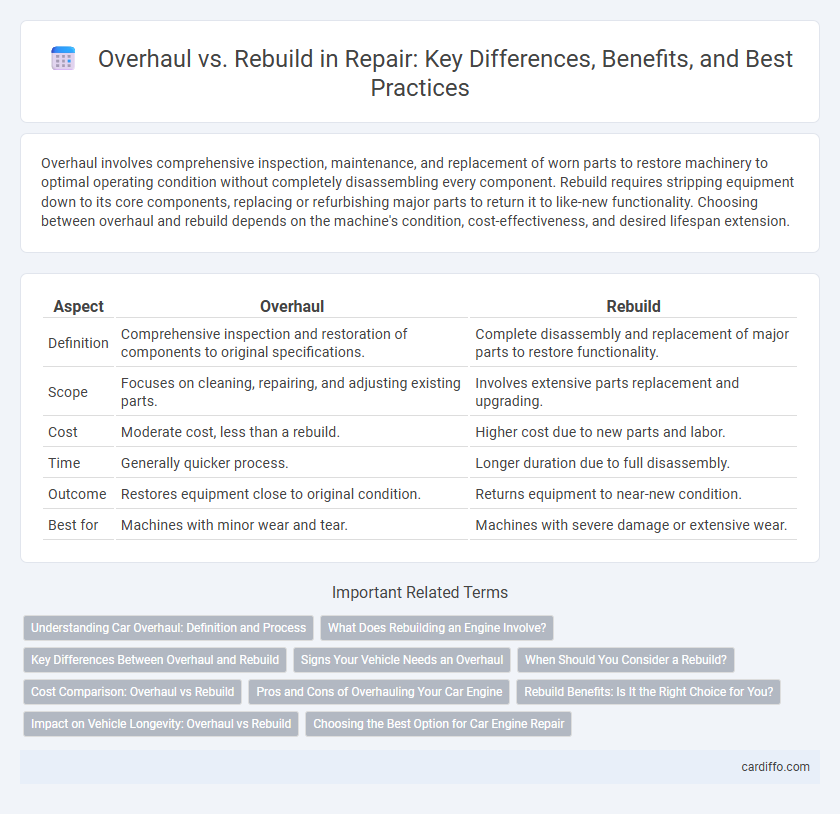Overhaul involves comprehensive inspection, maintenance, and replacement of worn parts to restore machinery to optimal operating condition without completely disassembling every component. Rebuild requires stripping equipment down to its core components, replacing or refurbishing major parts to return it to like-new functionality. Choosing between overhaul and rebuild depends on the machine's condition, cost-effectiveness, and desired lifespan extension.
Table of Comparison
| Aspect | Overhaul | Rebuild |
|---|---|---|
| Definition | Comprehensive inspection and restoration of components to original specifications. | Complete disassembly and replacement of major parts to restore functionality. |
| Scope | Focuses on cleaning, repairing, and adjusting existing parts. | Involves extensive parts replacement and upgrading. |
| Cost | Moderate cost, less than a rebuild. | Higher cost due to new parts and labor. |
| Time | Generally quicker process. | Longer duration due to full disassembly. |
| Outcome | Restores equipment close to original condition. | Returns equipment to near-new condition. |
| Best for | Machines with minor wear and tear. | Machines with severe damage or extensive wear. |
Understanding Car Overhaul: Definition and Process
Car overhaul involves a comprehensive inspection and restoration of the engine and major components to return the vehicle to optimal operating condition. This process includes dismantling, cleaning, repairing or replacing worn parts, and reassembling to meet factory specifications. Understanding the distinction between an overhaul and a rebuild lies in the extent of restoration, with overhauls focusing on repair and adjustment while rebuilds often require complete replacement of core components.
What Does Rebuilding an Engine Involve?
Rebuilding an engine involves completely disassembling the engine to inspect, clean, and replace worn or damaged components such as pistons, crankshafts, and bearings to restore optimal performance. This process includes machining engine parts to factory specifications and reassembling with new gaskets, seals, and often upgraded components to ensure durability and reliability. Rebuilding differs from overhauling by focusing more on component replacement and restoration rather than just cleaning and resurfacing existing parts.
Key Differences Between Overhaul and Rebuild
An overhaul involves inspecting, cleaning, and replacing worn components to restore equipment to its original operating condition, focusing on maintaining functionality without significant design changes. A rebuild goes further by completely disassembling, repairing, or replacing major parts, often upgrading or modifying components to extend lifespan or improve performance. Overhauls are typically less time-consuming and costly, while rebuilds require extensive labor and resources, reflecting their scope and complexity differences.
Signs Your Vehicle Needs an Overhaul
Persistent engine knocking, excessive oil consumption, and noticeable power loss are clear signs your vehicle requires an overhaul. Frequent overheating and poor fuel efficiency indicate internal engine wear that overhaul procedures can address. Engine misfires, unusual exhaust smoke, and metal shavings in the oil also signal the need for a comprehensive engine overhaul to restore performance.
When Should You Consider a Rebuild?
Consider a rebuild when extensive wear or damage affects critical components, making simple repairs insufficient to restore performance and reliability. Rebuilding is essential for engines or machinery with high mileage or severe internal issues such as cylinder wear, piston ring failure, or bearing damage. Opting for a rebuild maximizes lifespan and efficiency, often providing a cost-effective alternative to full replacement.
Cost Comparison: Overhaul vs Rebuild
An overhaul generally costs 30-50% less than a full rebuild due to the repair of existing components rather than complete replacement. Rebuilds involve higher expenses from new parts and extensive labor, often exceeding $5,000 for automotive engines compared to $2,500-$3,500 for overhauls. Choosing between overhaul and rebuild depends on the extent of damage and long-term durability requirements.
Pros and Cons of Overhauling Your Car Engine
Overhauling your car engine can restore performance by replacing worn components, improving fuel efficiency, and extending engine life. This process is generally more cost-effective than a full rebuild, as it involves less labor and fewer parts replaced, making it ideal for engines with moderate wear. However, overhauling may not address severe internal damage, leading to potential future repairs and limitations in restoring engine durability compared to a complete rebuild.
Rebuild Benefits: Is It the Right Choice for You?
Rebuilding offers significant benefits such as restoring equipment to like-new condition, extending lifespan, and improving performance at a fraction of the cost of replacement. It addresses both visible wear and hidden internal damage, ensuring long-term reliability and efficiency. Choosing to rebuild can minimize downtime and enhance asset value, making it an ideal option for heavy machinery and complex systems requiring cost-effective, thorough repair solutions.
Impact on Vehicle Longevity: Overhaul vs Rebuild
An overhaul restores a vehicle's engine by refurbishing existing components to extend its lifespan, often improving performance and reliability without replacing major parts. A rebuild replaces worn or damaged parts, essentially creating a near-new engine, substantially increasing vehicle longevity and reducing future repair costs. Choosing between overhaul and rebuild impacts maintenance schedules, resale value, and overall durability of the vehicle.
Choosing the Best Option for Car Engine Repair
Overhaul and rebuild are two critical approaches to car engine repair, each with distinct scopes and benefits. Overhaul involves thoroughly inspecting and restoring engine components to extend engine life without complete disassembly, ideal for addressing wear and improving performance. Rebuild requires disassembling the engine entirely, replacing or machining major parts like pistons and cylinders, making it the best option for severe damage or complete engine failure.
Overhaul vs Rebuild Infographic

 cardiffo.com
cardiffo.com